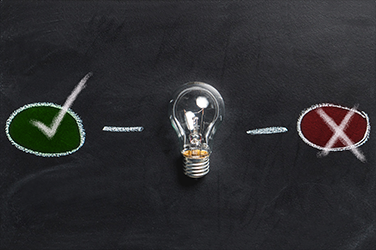Which of the two sentences below is correct?
- I believe that I mentioned that yesterday.
- I believe I mentioned that yesterday.
And how about these two?
- The woman that you saw me with was my sister.
- The woman you saw me with was my sister.
The answer in each case is that both sentences are correct! The reason has to do with subordinating conjunctions, relative pronouns, rhythm and clarity. Let me break it down into digestible steps!
Subordinating conjunctions and relative pronouns
When you say “I believe that I mentioned that yesterday,” the first “that” acts as a subordinating conjunction. It creates a dependent clause (“that I mentioned that yesterday”) and joins it to a main clause (“I believe”).
So why is the second sentence correct, too? Because you have the option to omit the subordinating conjunction (the first “that”). So it’s equally acceptable to say “I believe I mentioned that yesterday.” (And many people would prefer this sentence, to avoid repeating “that.”)
Now for the second pair of sentences. In the sentence “The woman that you saw me with was my sister,” “that” is a relative pronoun. Its role is very much like the role of “that” in the first pair of sentences: it creates a dependent clause (“that you saw me with”) and joins it to a main clause (“The woman was my sister”).
The relative pronoun “that,” like the subordinating conjunction, can be omitted in many cases. So it’s fine to say “The woman you saw me with was my sister.”
Here’s what the Oxford Guide to Canadian English Usage (second edition) has to say:
Especially in spoken English, “that” is often omitted.... In the eighteenth century, usage writers condemned the omission of “that” in written English. Now some usage guides maintain just the opposite, that it is better to omit “that” whenever possible. Since both structures are grammatically correct, rhythm and clarity should guide your choice.
In terms of rhythm, the Guide says to omit “that” if the sentence sounds better without it. With regard to clarity, the Guide says to use “that” to avoid misunderstanding. So here are some guidelines to help you make the decision.
When to omit “that”
-
You may omit “that” after common verbs of speech or thought
(like “say,” “believe,” “claim,” “hear,” “think,” “feel,” “know”).
Lloyd thinks
thatI can pass my Level 1 instructor certification. -
You may omit “that” to avoid unnecessary repetition.
I believe
thatI mentioned that yesterday.
Meryl thinksthatthat hill is too steep for her.In both the above examples, one “that” is better than two.
So should you strive to omit “that” whenever possible? Not necessarily. There are times when “that” should not be omitted.
When to use “that”
-
Use “that” when the pronoun is the subject of its own clause.
The book
thatyou dropped belongs to the library.
BUT
The book that fell off the shelf belongs to the library.In the first sentence, “that” can be omitted. But it can’t be omitted in the second sentence, because it is the subject of the verb “fell” and the sentence wouldn’t make sense without it.
-
Use “that” if there is a danger of misreading.
For example, consider this sentence:
During the lockdown, the teachers found two-thirds of the students needed assistance.
When people first begin reading this sentence, they might expect to read something like “During the lockdown, the teachers found two-thirds of the students cowering in the gym.”
In other words, without the subordinating conjunction “that,” readers might think at first that “two-thirds of the students” is the object of the verb “found.” So they might do a double take when they get near the end, and have to read the sentence over again.
If you use “that,” they can’t misread what follows. They will expect to read a subordinate clause:
During the lockdown, the teachers found that two-thirds of the students needed assistance.
-
Use “that” to introduce two or more parallel clauses.
The sentence below contains a very common error:
Rashid said he had prepared the PowerPoint presentation and that the boss would show it at the next meeting.
In this sentence, there are two dependent clauses; and with a series of two or more clauses, it’s important to maintain parallel structure. But only the second dependent clause starts with the conjunction “that,” so the clauses aren’t parallel.
To keep the structure parallel, use “that” before both dependent clauses:
Rashid said that he had prepared the PowerPoint presentation and that the boss would show it at the next meeting.
-
Use “that” after the verbs “shout” and “reply.”
Someone shouted that one of the children needed help.
The teacher replied that he was on his way. -
Use “that” in a noun clause that follows a noun.
Her statement that she was quitting took me by surprise.
I disagree with their opinion that the product is safe. -
Use “that” when an introductory or interrupting element comes between “that” and the subject of the dependent clause.
The cardiologist feels that, in my case, the heart murmur is more pronounced because of my age.
-
Use “that” if you’re in doubt.
When in doubt, don’t throw it out. It’s safer to use “that” if you’re not sure.
So, that’s that with “that”! Now you know when you can omit this tricky little word and when you have to use it.
Want to practise what you’ve learned? Try our quiz!

